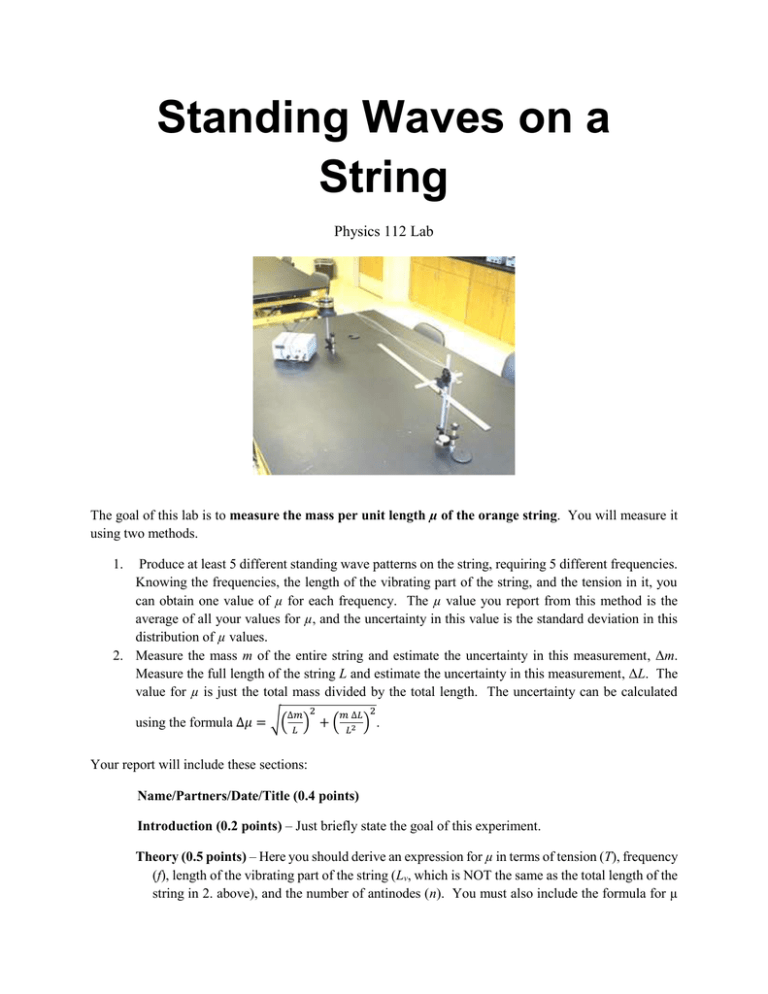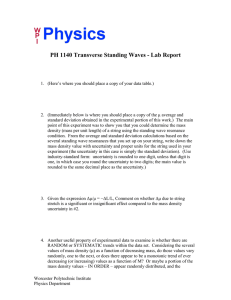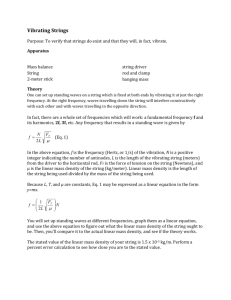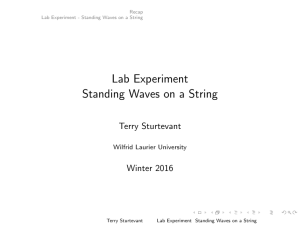Standing Waves on a String
advertisement

Standing Waves on a String Physics 112 Lab The goal of this lab is to measure the mass per unit length µ of the orange string. You will measure it using two methods. 1. Produce at least 5 different standing wave patterns on the string, requiring 5 different frequencies. Knowing the frequencies, the length of the vibrating part of the string, and the tension in it, you can obtain one value of µ for each frequency. The µ value you report from this method is the average of all your values for µ, and the uncertainty in this value is the standard deviation in this distribution of µ values. 2. Measure the mass m of the entire string and estimate the uncertainty in this measurement, Δm. Measure the full length of the string L and estimate the uncertainty in this measurement, ΔL. The value for µ is just the total mass divided by the total length. The uncertainty can be calculated ∆𝑚 2 ) 𝐿 using the formula ∆𝜇 = √( 𝑚 ∆𝐿 2 ) . 𝐿2 +( Your report will include these sections: Name/Partners/Date/Title (0.4 points) Introduction (0.2 points) – Just briefly state the goal of this experiment. Theory (0.5 points) – Here you should derive an expression for µ in terms of tension (T), frequency (f), length of the vibrating part of the string (Lv, which is NOT the same as the total length of the string in 2. above), and the number of antinodes (n). You must also include the formula for µ used in method 2, but there is no need to derive it as it is a definition. All variables should be defined. Experiment (2.0 points) – Must include a diagram and all of your data plus uncertainties. Remember, you for each standing wave, you measure Lv, n, f, and T. (Well, Lv and T will be the same in each case.) Analysis (1.0 points) – Calculate your two values of µ and their uncertainties. Discussion (0.5 points) – Do your two values of µ agree? (If the ranges defined by their uncertainties overlap, then they agree.) If not, re-check your measurements. If you are convinced they are correct, then you must figure out why they do not agree. (“We screwed up” is a terrible reason!!! Repeat the measurements if you screwed up. Would you report bad data to your boss?) Conclusion (0.4 points) – Briefly sum up your results (your two values of µ with uncertainties). If they agree, say so. If not, then sum up your best reason why. The basic setup of the experiment looks like this: string “speaker” frequency generator pulley weights The weights provide tension in the string. Keep the tension constant and change the frequency to get a different number of antinodes on the string. Helpful Hints 1. Keep the amplitude of the signal generated by your frequency generator as low as you can but still be able to see standing waves. All the noise in the classroom will drive everyone nuts. 2. The frequency that gives you the largest amplitude standing wave is the frequency you should record. It is best to start at too low a frequency and gradually increase it. Go past where the amplitude is maximized and come back down slowly. You should be able to zero in on it. 3. If you want a piece of equipment that you do not see available, ask me and I’ll do my best to get you what you need. This applies to all experiments done in Physics 112. Again, it might be fastest to write up your report as you do the experiment. It is due no earlier than Monday, but I’ll always take reports sooner than that.







